Pimp My Pistou: A Recipe Tour of France
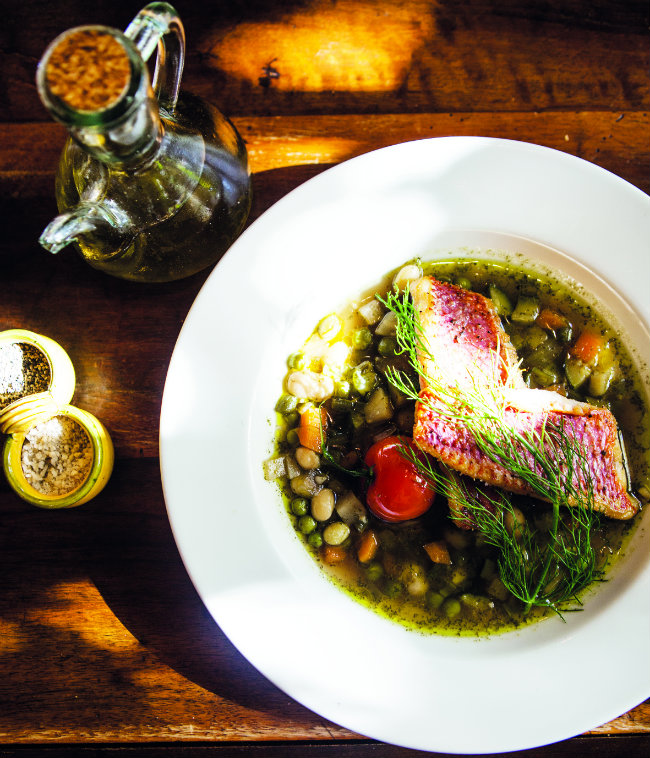
Join us on a gastronomic journey across France, as we lift the lid on some of its best-loved recipes and meet the chefs who have put their stamp on them
These recipes have been excerpted with permission from France – From the Source by Carolyn Boyd. Authentic recipes from the chefs who know them best. Photography © River Thompson. Published by Lonely Planet Food, £19.99, hardback.
SOUPE AU PISTOU
Pistou soup
Serves 4 | Preparation and cooking time: 1hr (not including soaking of beans)
In the idyllic surrounds of an 18th-century farmhouse, chef Thierry Crovara uses the fresh basil grown in his bountiful herb garden in a soup that has long been a favourite dish among the people of Provence, but which also bears a striking resemblance to a famous Italian dish.
“We are in the garden of France, here in the Luberon,” says Thierry, as he surveys his large herb garden, which is just a few steps from the kitchen of his homely hotel-restaurant. “We have the sun here and we have the water. It’s green everywhere because the water table is just five metres underneath the ground.”
Perhaps better known for its acres of lavender and vineyards, the Luberon area of Provence is home to farms and growers providing a bounty of produce to kitchens near and far. Many of the vegetables find their way into the Provençal dish, soupe au pistou – a soup that encompasses a host of different flavours. “It’s a traditional recipe from the Mediterranean with basil, garlic and olive oil. We eat it hot, but also cold. It’s a country recipe, so if they didn’t have beans, for example, they’d just put in something else. You can put in whatever you like,” says Thierry, who cooks a variety of Provençal and French dishes for the hotel’s daily table d’hôte, served in the dappled shade of the wisteria-clad terrace. “The people of Provence will tell you, ‘It’s our recipe’, but in Italy it’s called minestrone, it’s almost exactly the same thing – only they use pasta and we use potatoes,” he explains.
The clue to the Italian connection also comes in its name: pistou and pesto are largely the same thing and the French and Italians will gladly debate the ingredients of their pistous and pestos, with the latter containing pine nuts and cheese. Some will insist the basil leaves are small and young, others that they are torn from their stalks to ensure a smooth consistency. Whatever is decided by the individual cook, the highlight of soupe au pistou, or indeed minestrone, is the dollop of pesto stirred in at the end, giving the dish the refreshing aroma of basil and the heady taste of garlic.
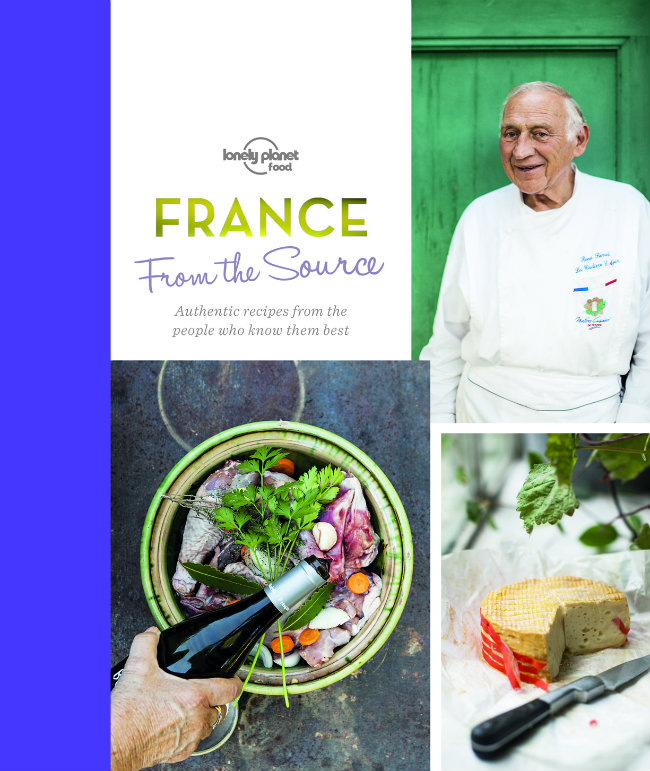
INGREDIENTS
500g (1lb) uncooked white haricot beans
100g (3 oz) onion
200g (7oz) carrots
100g (3 oz) celeriac
150g (5 1/3oz) courgettes (zucchini)
150g (5 1/3 oz) French beans
3 tsp olive oil
2L (70 oz) chicken stock
salt, to taste
freshly ground pepper, to taste
150g (5 1/3oz) potatoes
100g (3 oz) basil
1 head garlic, peeled and chopped finely
1 Put the dried beans in a bowl covered with water and soak overnight.
2 Peel and cut the onion, carrots and celeriac into cubes. Wash and cut the courgette into cubes. Cut the French beans into 2 cm (1in) sections.
3 In a saucepan, heat 1 tsp of the olive oil and sauté the onions, carrots and celeriac until they soften slightly, but don’t let them colour.
4 Add two litres of stock.
5 Drain the white beans and add them to the soup, simmer for 30 minutes, season.
6 Peel and cut the potatoes into cubes. Then add the potatoes, French beans and courgettes and cook for 20 minutes.
7 Just before taking off the heat, season again.
8 Mix the basil with the remaining 2 tsp of olive oil, then add to the soup. Add the chopped garlic, without reheating. Serve in warmed bowls.
Tip: To turn this dish into a main meal, add fillets of red mullet (30g/1oz apiece), simply season them and fry them in a bit of olive oil on the skin side, then turn them until cooked through. Place them on top of the soup just before serving.
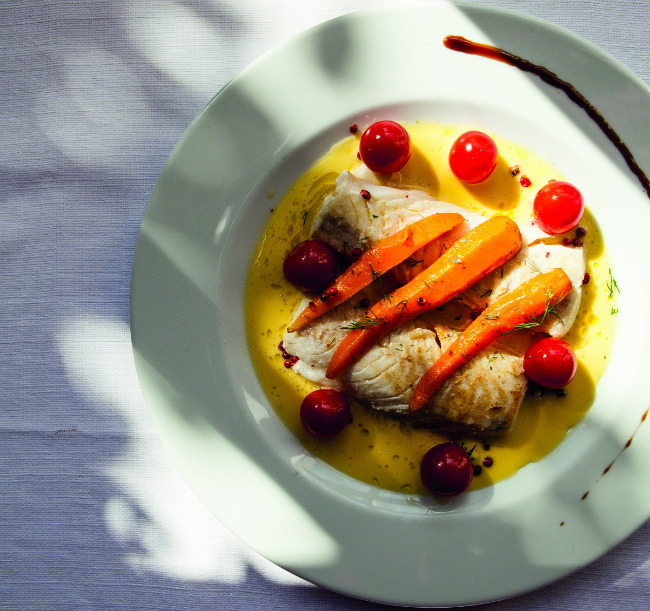
Poisson au beurre blanc © Lonely Planet, River Thompson
POISSON AU BEURRE BLANC
Whitefish with white wine butter sauce
Serves 4 | Preparation and cooking time: 40min
Ask any local from the Loire – from Orléans to Nantes – to name a classic dish from the region and it is the beurre blanc with river fish they will undoubtedly recommend. Made with butter and white wine, it is similar to hollandaise or Béarnaise sauce but without the egg yolks.
Despite its simple ingredients, its technique is one to master over time. After 30 years serving it to guests at the magical Château des Briottières, Hedwige de Valbray has perfected the art: “The hard part is stopping the butter from melting. That’s why people add in the cream, it emulsifies it,” she says. “You have to serve it immediately. It’s quite rare to see [on menus] – you don’t often find it in Paris restaurants, because it’s so fragile.”
The traditional fish to serve it with was pike, found in abundance in the River Loire, but Hedwige is not a fan. “It has lots of bones and rather a muddy flavour.” Little wonder, then, that those living along France’s longest river found a way to make it more enticing. “That’s why they invented a sauce, to soften it,” she says. While pike is not often the order of the day now, the sauce remains a classic and is used to enhance whitefish, scallops, pork and chicken.
Hedwige serves the mouthwatering beurre blanc over zander, or pike-perch, as she has always done here. Her kitchen is just metres from the elegant dining room, so the dish can be whisked quickly to the table. These more delicate river fish are more fitting for the setting – one of the most elegant châteaux in the Western Loire. “The pike was eaten by fishermen, it was a poor person’s food,” says Hedwige, “but in the châteaux, they would eat zander with beurre blanc. It’s a very old recipe.”
INGREDIENTS
boiled potatoes, to serve
garden vegetables, to serve
4 shallots, chopped finely
250ml (8 oz) white wine (ideally Muscadet)
200g (7 oz) whitefish per person (ideally zander, or cod if unavailable)
250g (8 oz) unsalted butter, cut into cubes
3 tbsp single cream (optional)
squeeze of lemon juice (optional)
salt, to taste pepper, to taste
1 Bring a saucepan of water to the boil and add the potatoes. Simmer until cooked (roughly 15 minutes), then set aside.
2 Add your choice of garden vegetables to a steamer. Steam for 5-10 minutes until cooked, then set aside.
3 Put the shallots and wine in a casserole dish with a large base. Simmer until the wine has all evaporated (approx five minutes).
4 In a steamer, steam the fish over a medium heat until it is cooked through. Keep warm and covered until ready to serve.
5 Over a very low heat, vigorously stir (or whisk) in the butter a little at a time so it softens and thickens, but don’t let it melt. If it starts to melt, add the single cream and a squeeze of lemon juice.
6 Add salt and pepper, then pass the sauce through a sieve to eliminate the shallots.
7 Pour over the fish and serve immediately.
8 Serve with the boiled potatoes and garden vegetables.
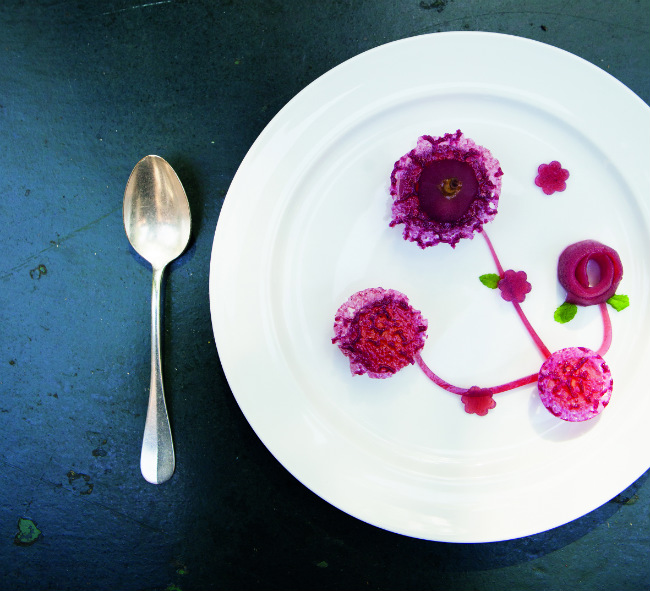
Les poires au vin rouge © Lonely Planet, River Thompson
LES POIRES AU VIN ROUGE
Pears in red wine
Serves 10 | Preparation and cooking time: 1hr 30min (not including 48 hours to marinate pears)
Based on the traditional recipe of pears stewed in Beaujolais red wine, chef Stéphanie Moreau creates a dessert that brings together three of Burgundy’s favourite fruits: the pear, the grape and the blackcurrant.
From hearty stews to savoury cakes, wine seems to find its way into most recipes that originate in Burgundy, and that doesn’t stop at the dessert trolley. The traditional recipe, poires à la bonne femme, was designed to use up the pears that had not properly ripened and consisted of the fruit being boiled in sugar to disguise its grainy texture before wine was added for colour rather than flavour. During this process, the skin would go wrinkly, supposedly like an ‘old wife’, or ‘bonne femme’, which is how it got its name.
In this aromatic dessert, created by Stéphanie, the pears get a further boost in flavour by being marinated in wine for two days, along with citrus fruit, and cinnamon, which lend it a festive feel. As chef at the bucolic Moulin des Ruats, hidden in woods in the wildly beautiful Parc Naturel Régional du Morvan near Avallon, Stéphanie’s favoured method sees the pears gently infused with the wine, rather than boiling them in it. “It improves the taste of the wine,” she explains.
Working at the cosy former watermill, Stéphanie has developed the dish into a sophisticated dessert that leaves its rustic roots firmly in the past. She serves it with a chocolate sorbet or ice cream, a red wine jelly and a tuile wafer that is made with one of Burgundy’s other key ingredients: blackcurrants. “You can use blackcurrant sorbet instead of chocolate to carry through the blackcurrant theme,” says Stéphanie, adding: “The tuile gives the dish an extra crunch, which works with the softness of the pears.”
INGREDIENTS
For the pears & red wine jelly
10 pears
1L (1 pt) Pinot Noir red wine
1L (1 pt) water
zest & juice of 1 orange
zest & juice of 1 lemon
1 cinnamon stick
6g (1/4 oz) agar-agar powder
For the tuile
410g (14 oz) blackcurrant purée
35g (1 oz) flour
220g (7 oz) icing sugar
20g (3/4 oz) butter
chocolate sorbet, to serve
mint leaves, to garnish
1 Peel the pears (leaving the stalks in place) and place in an airtight container with the red wine, the water, orange juice and its zest, lemon juice and its zest, and cinnamon stick, and leave in the fridge for 48 hours.
2 Prepare the tuile by mixing the purée, flour, icing sugar and butter in a food processor.
3 Place teaspoons of the tuile mixture onto a sheet of greaseproof paper and spread it out in circles of approx. 5 cm (2 in) in diameter with your finger. Place in the fridge overnight.
4 Take the pears from the fridge and remove them from the red wine, reserving the liquid. Cut the pears in quarters horizontally and core each piece with an apple corer (this indentation will be filled with chocolate sorbet later).
5 To make the jelly, put 200ml (7 oz) of the reserved wine mixture in a pan with the agar-agar and bring to the boil until it starts to thicken.
6 Line a large baking sheet with cling film and pour the warm jelly mixture onto it. Spread out to a thickness of about 3mm-5mm (up to 1/4 in). Place in the fridge for about 30 minutes.
7 Remove the tray of tuiles (from step 3) from the fridge and bake in a preheated oven for
10 minutes at 150°C (300°F). They should appear slightly transparent. While still warm, cut each tuile in a neat circle with a pastry cutter. Leave to cool.
8 When ready to serve, fill the centre of each piece of pear with the chocolate sorbet, and arrange the pears on the plate with slices of the jelly and the tuile, and small mint leaves
to garnish.
Tip: When cutting the pears, if you want to make it very neat, use three different sized smooth-sided pastry cutters to cut out the largest three pieces. Roll up the excess from the largest piece into a rose-like shape to decorate the plate.
This extra touch is a nod to the blackcurrants that were traditionally grown alongside the grapes by the wives of Burgundy winegrowers. While the main harvest was, of course, the wine, the blackcurrants were used to create the local liqueur named crème de cassis, which – like the wine – also finds its way into many a dessert in this corner of France.
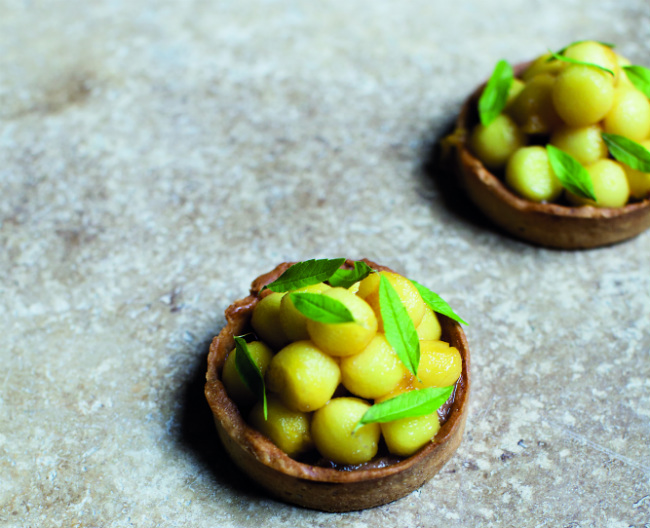
Tartelette pomme rhubarbe © Lonely Planet, River Thompson
TARTELETTE POMME RHUBARBE
Apple & rhubarb tartlet
Serves 4 | Preparation and cooking time: 1hr 15min
Among the farms and fields of eastern Normandy, chef Jordan Fouchet makes the most of the best local produce for his delicate apple and rhubarb tartlet served at the chic Manoir de Surville, a favourite escape for Parisians. And when the ingredients aren’t available, seasonality provides a perfect solution.
In the land around the pristine village of Surville, south of Rouen in eastern Normandy, the wheat elds roll with the seasons. In spring, the crop is just burgeoning green sprouts, but by late summer the fields have become a sea of gold, rippling in the breeze. The harvested wheat is then ground to become our and goes on to be used in a wonderful array of breads, cakes and tarts across France.
In the heart of the village, the seasons also come into play for a simple fruit tart created by Jordan, which is served at the Manoir de Surville. At the stylish B&B, set in a beautifully restored farmhouse, Jordan picks the best produce to create his dessert. “It’s better to work with local products. They’re fresh, seasonal and that’s important,” he says. This being Normandy, the obvious fruit to include are its famous apples, which he couples with rhubarb, sourced from a farmer just 15 minutes from the Manoir. But in the height of summer, when the rhubarb harvest is slowed to allow the plant to gain energy stores for the winter, there is less available. So what to do when you can’t find your chosen ingredient? Jordan’s answer is simple: adapt the recipe.
“The compote can be any fruit. In summer, you can use strawberries, cherries, peaches. As long as the compote is reduced down [and not too watery], it will work well in the tart.” You can then simply caramelise slices of another fruit to put on the top. For added freshness, his cuisine draws on garden herbs, particularly verveine (lemon verbena), a herb that the French adore, thanks to its citrus aroma. As he places the tiny green leaf on the top of the perfectly poised apple globes, Jordan declares:“Voilà! It’s ready to taste!”
INGREDIENTS
For the pastry
250g (8 3/4oz) plain flour, plus extra for rolling the pastry
100g (3 1 2oz) icing sugar
30g (1oz) ground hazelnuts (or ground almonds)
pinch of salt
100g (3 1/2 oz) butter
1 egg yolk
For the compote
2 sticks of rhubarb
seeds from 1 vanilla pod
20g (3/4 oz) butter
100g (3 1/2 oz) caster sugar
water, optional
2 Jonagold apples (or firm-fleshed apples)
verbena leaves, to serve
vanilla ice cream, to serve
FOR THE PASTRY
1 In a bowl (or food processor), mix the flour, icing sugar, ground hazelnuts and salt. Then add the butter.
2 Add the egg yolk and combine.
3 Form the mixture into a ball, wrap in cling film and put in the fridge for 30 minutes.
FOR THE COMPOTE
1 Wash the rhubarb and cut it into small cubes.
2 In a saucepan, add the rhubarb, vanilla seeds, the butter and half of the sugar and cook for 30 minutes. Add a small amount of water if it starts to boil dry. Put in a bowl and bring to room temperature before setting aside in the fridge until ready to serve.
3 Peel and core the apples, and then use a melon baller to create small globes.
4 Pour the remainder of the sugar into a frying pan and add the apple globes. Fry for six to eight minutes until the apples are caramelised.
Tip: The apple globes are quite tricky to create (it takes practice!), half-circles do just as well or cut them into cubes. You can also make one large tart, rather than four small ones.
As seen in France Today magazine
Share to: Facebook Twitter LinkedIn Email
Leave a reply
Your email address will not be published. Required fields are marked *




REPLY
REPLY